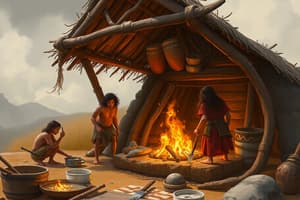Podcast
Questions and Answers
Which of the following was NOT a reason for the nomadic lifestyle of early humans?
Which of the following was NOT a reason for the nomadic lifestyle of early humans?
- Developing advanced farming techniques (correct)
- Searching for food, water, or shelter
- Migrating to various areas
- Following herds of animals
The Neolithic Revolution marked the transition from nomadic hunting-gathering societies to permanent farming communities.
The Neolithic Revolution marked the transition from nomadic hunting-gathering societies to permanent farming communities.
True (A)
What were some of the first animals that early humans began to domesticate?
What were some of the first animals that early humans began to domesticate?
Dogs, pigs, goats, and horses
Catal Huyuk is located in modern-day ______.
Catal Huyuk is located in modern-day ______.
Match the following tools or roles with their descriptions:
Match the following tools or roles with their descriptions:
What type of materials were the homes in Catal Huyuk primarily made of?
What type of materials were the homes in Catal Huyuk primarily made of?
It is believed the villagers of Catal Huyuk had open doorways in their homes.
It is believed the villagers of Catal Huyuk had open doorways in their homes.
What deity is believed to have been important in the daily lives of the people of Catal Huyuk?
What deity is believed to have been important in the daily lives of the people of Catal Huyuk?
Catal Huyuk is characterized as a _______ community rather than a full civilization.
Catal Huyuk is characterized as a _______ community rather than a full civilization.
Match the following features to their descriptions:
Match the following features to their descriptions:
Flashcards are hidden until you start studying
Study Notes
Tools of Survival
- Earliest modern humans lived as hunter-gatherers, relying on foraging and hunting for food.
- Communities typically consisted of 25 to 50 nomadic individuals, migrating in search of resources like food, water, and shelter.
- Nomadic lifestyle meant no permanent settlements, leading to daily necessity for resource acquisition.
- Development of tools was crucial; early tools included wooden digging sticks and stone-headed axes, marking the Stone Age.
- Weapons created for hunting included bows and arrows, knives, spears, and harpoons.
A Farming Revolution
- Transition from hunter-gathering to food-producing societies represented a major advancement in human history.
- Early humans started domesticating animals (dogs, pigs, goats, horses) for companionship and food.
- Domestication facilitated a shift toward permanent settlements.
- Introduction of agriculture allowed for small farming villages to grow and sustain steady food supplies.
- Permanent settlements led to population growth and specialization of labor; some individuals became craftspeople, scribes, or record keepers.
Catal Huyuk
- Catal Huyuk, discovered in 1958 in modern Turkey, is one of the earliest and best-preserved farming villages, dating back to around 6,000 B.C.
- The village may have supported 5,000-6,000 residents who cultivated wheat, barley, and raised domesticated animals.
- Architectural layout featured homes built rectilinearly with adjoining structures made of mud-brick, enhancing communal living.
- Villagers likely accessed their homes via roofs for added security, as evidenced by the absence of ground-level entrances.
- The site contained elaborate shrines dedicated to a "mother goddess," indicating the importance of religion and divine control over agriculture.
Civilizations
- As settlements like Catal Huyuk grew, they evolved into cities, leading to the rise of the first civilizations.
- Distinguishing features of civilizations include:
- Record keeping systems
- Specialized workforce
- Advanced population densities
- Development of urban centers
- Complex institutions
- Early civilizations emerged in fertile river valleys, such as Mesopotamia, Egypt, India, and China, which supported agriculture and population growth.
Studying That Suits You
Use AI to generate personalized quizzes and flashcards to suit your learning preferences.




